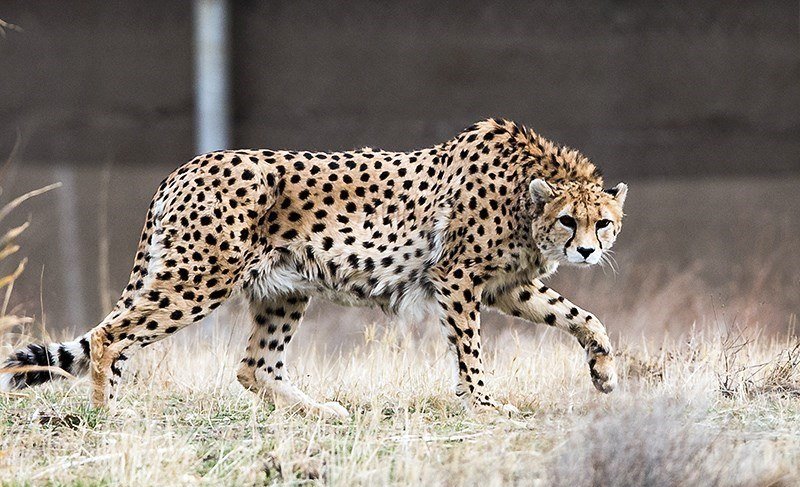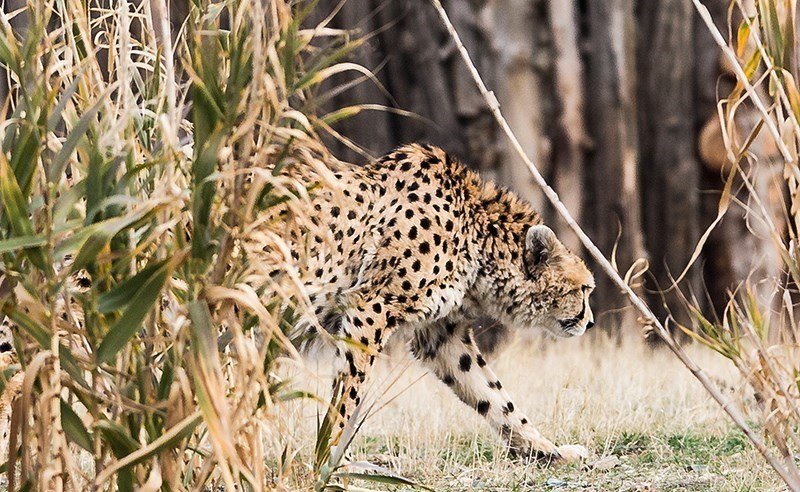Conservation a ‘never ending’ effort as it confronts ‘never ending’ disturbance processes

The Asiatic cheetah nowadays only exists in Iran where its survival raises multiple challenges. To prevent the extinction of this iconic cat species from its last refuge in Asia, it is essential to draw the attention of people and generate enough positive support.
No matter how hard and difficult it appears to be, we should not try to escape from our collective responsibility, and undertake everything in our possibilities to save the cheetah.
In order to highlight the importance of the Asiatic cheetah conservation, the Tehran Times have conducted an interview with Dr. Stéphane Ostrowski, who has recently done a review of the performance of the Conservation of the Asiatic Cheetah Project (CACP), the responsible organization in Iran for the conservation of the Asiatic cheetah since 2001.
Dr. Ostrowski has worked in the field of wildlife conservation since 1993, starting in the Middle East as a project manager for the successful re-establishment of the Arabian oryx, a charismatic desert-adapted antelope. He is currently a scientific adviser for the Wildlife Conservation Society (WCS) in central and western Asia where he has been working with a variety of conservation projects from Iran to Mongolia, aiming at saving emblematic habitats and species such as the Asiatic cheetah, snow leopard and Marco Polo sheep.
He has a solid scientific background, validated by numerous peer-reviewed publications, as well as a long experience in conservation project management. Through mentorship Dr. Ostrowski has been technically supporting conservation projects in the Persian-speaking world, including in Afghanistan, Iran and Tajikistan.
Below is the text of the interview.
Q: When did Conservation of Asiatic Cheetah Project (CACP) spark your interest?
A: Wildlife conservation in Iran sparked my interest since the very first days of my dedication to wildlife conservation, now more than 20 years ago, but it is only in 2007 that I have had the chance and privilege to start collaborating with CACP, six years after the project was created under a combined Department of Environment (DoE), Global Environment Facilities (GEF) and United Nations Development Program (UNDP) initiative.

Q: What were the reasons of your interest in wildlife of Iran? And why cheetahs?
A: I believe that Iran hosts a rare and unique assemblage of wildlife and habitats in western Asia and the Middle East. Also, biodiversity related activities in Iran can generate considerable potential global benefits and comparatively more than in any other countries in the region. Finally, it is also home to a motivated, passionate, and highly capable new generation of promising conservationists, biologists and environmentalists. In combination, these factors provide a promising background to support wildlife conservation activities in the country.
CACP operation suffered from low and unstable funding, frequently changing leadership at the DoE level, and a lack of collaboration between national partners involved in conservation activities.
The Asiatic cheetah is an emblematic species, because it nowadays only survives in Iran, it is beautiful and charismatic and may therefore attract considerable attention and support from the people. This support may result in genuine public engagements and also help save less charismatic species such as a number of bird, reptile, amphibian or insect species nowadays exposed in Iran to unsustainable harvesting, trade and habitat degradation because of increasing human footprint and demands on natural resources.
Q: In your opinion, how long will it be before we can say that the Asiatic cheetah no longer needs conservation efforts?
A: Conservation is a battle against the decay and death of dynamic natural systems, such as medicine is against diseases destroying organisms. Will diseases eventually disappear and medicine end? Probably not in the near future. Similarly, conservation is a ‘never ending’ effort as it confronts ‘never ending’ disturbance processes. Asiatic cheetah conservation should continue whether the population grows back to safe levels or drops to quasi-extinction, and as long as the environmental decaying processes that we generate will operate.
Q: Several experts pointed to the threat posed by dogs (livestock guard and feral) responsible for Asiatic cheetah deaths, how serious is this threat?

A: It is notoriously difficult to detect death in wildlife unless it happens as a mass mortality event. Unfortunately, few of the dead cheetahs recorded in Iran in the last 15 years have been thoroughly examined by forensic veterinarians. As a result, unless obvious, such as in the case of road kill, the causes of death of cheetahs in Iran have more been suspected than confirmed by informed examinations.
I believe that the threat posed by dogs to cheetahs in Iran is real and requires developing protection measures as quickly as possible.
With this in mind, it is correct that indirect evidence supports that a number of Asiatic cheetahs, especially in the north of the species’ distribution range have been victims to feral or livestock guard dogs. I believe that the threat posed by dogs to cheetahs in Iran is real and requires developing protection measures as quickly as possible. The magnitude of this threat should be assessed with more research and a better mobilization of the available expertise in wildlife forensics.
Q: What is your opinion about the possibility of transferring Canine Distemper Virus (CDV) to Asiatic cheetahs and Persian leopards?
A: Canine Distemper Virus, which is present in Iran, is a viral pathogen of particular importance to most terrestrial carnivore species including wild felids such as the Persian leopard and the Asiatic cheetah. An infection by CDV would have the potential to render these two species sick or even kill them. The most likely source of infection in solitary large cats is assumed to be direct transmission when predating infected animals. As such because the Persian leopard is more likely to consume infected carnivores than the Asiatic cheetah, the former species is probably more exposed to a risk of CDV infection.
Q: Several Iranian experts pinpointed to the priority of collar tracking for Asiatic cheetahs. How effective do you think the methodology is?
A: Radio-collaring is a modern methodology that allows to retrieve a wealth of very valuable information on the biology, ecology and needs of an animal by fixing a tracking device around its neck. The collected information is useful to develop sound conservation measures based on solid scientific grounds. However, radio-collaring is also an intrusive method that depends on stressful capture and handling operations, and that could under certain circumstances affect the fitness and survival of the tracked animal. Given the extreme rarity of the Asiatic cheetah and the immense genetic value of every single individual of this critically endangered population, the risk related to the capture and anesthesia of free-ranging cheetahs will have to be assessed against the anticipated conservation benefits.
I believe that Iran hosts a rare and unique assemblage of wildlife and habitats in western Asia and the Middle East. Also, biodiversity related activities in Iran can generate considerable potential global benefits and comparatively more than in any other countries in the region.
Q: According to some critics CACP has had few achievements so far. Are those criticisms fair?
A: I have done a review of CACP achievements between 2010 and 2016. The results of this evaluation will soon come public, but in brief the conclusion is that CACP reached some degree of achievements for 63% of the activities proposed in their Action Plan developed in 2010 with the help of recognized national and international experts in cheetah conservation. Albeit this reasonably high level of achievement, the Asiatic cheetah remains critically endangered. CACP operation suffered from low and unstable funding, frequently changing leadership at the DoE level, and a lack of collaboration between national partners involved in conservation activities.
Q: Some say CACP overestimates the size of the Asiatic cheetah population. They claim that they can count cheetah with reliable accuracy using their camera traps, what is your point of view?
A: Currently no one in Iran has the ability to determine with reliable accuracy the size of the cheetah population living in the country, and disputes over this topic are therefore pointless. There are several reasons for this inability but an important one is that none of the existing methods are easy to adapt to an animal species surviving at very low density over an area of suitable habitat larger than Italy. Also, the resources needed to achieve such task at such scale have so far not been available to CACP or any of its partners. Independently of these methodological constraints, the hypothesis of a decline in cheetah population size in Iran is legitimate based on the documented decline in prey species and on the shrinking number of presence records despite increasing survey efforts.

Q: What would be the required camera trap effort in Iran to derive reliable estimates of the cheetah population size?
A: It is a question that would require an in depth discussion between specialists. Whether only camera-trapping is the panacea or a combination of methods must also be discussed. Having said that, knowing cheetah numbers is a legitimate conservation task, yet not one that will directly save the Asiatic cheetah from extinction. Considering the urgency of the situation, significantly more resources and energy should be devoted to act on the ground and resolve real issues that directly threaten cheetahs, such as increasing by all possible sustainable ways their main prey numbers, which means controlling widespread gazelle poaching, reducing livestock grazing pressure (they compete with wild ungulates for food and transmit diseases to them) and dog numbers in protected areas, and protecting cheetahs from being killed by cars. So far the scale of the investment of Iran in cheetah conservation has been relatively modest considering the wealth of the country and in comparison to what was invested to save other rare cats from extinction, such as the Iberian lynx in Spain.
Asiatic cheetah conservation should continue whether the population grows back to safe levels or drops to quasi-extinction, and as long as the environmental decaying processes that we generate will operate.
Q: There is an on-going grassroots campaign that tries to collect money for reducing livestock numbers in Touran National Park. It is a popular campaign because several Iranian celebrities' endorsed it and directly involved in fund raising. Given your knowledge of Touran National Park, what is your idea? To which extent this initiative could help cheetahs?
A: Personally I am very supportive of any participatory and transparent initiative, which could help secure food resources for wildlife in protected areas and decrease drastically the number of dogs in one of the most famous national parks in Iran. Cheetahs and associated prey species must have access to safe havens with minimal human and livestock disturbance. In Iran, protected areas cover about 10% of terrestrial land, although relatively modest in comparison of the world average of about 15%, these 10% should, at least, play the protection role assigned to them. Finally I am also hoping that this fund raising operation will lead the path for many such initiatives, and increase the philanthropic involvement of the civil society to save the precious wildlife and habitats of Iran.
Iranians should embrace massively cheetah conservation not only because the Asiatic cheetah only survives in Iran, but also because they are custodians of a world heritage.

Leave a Comment